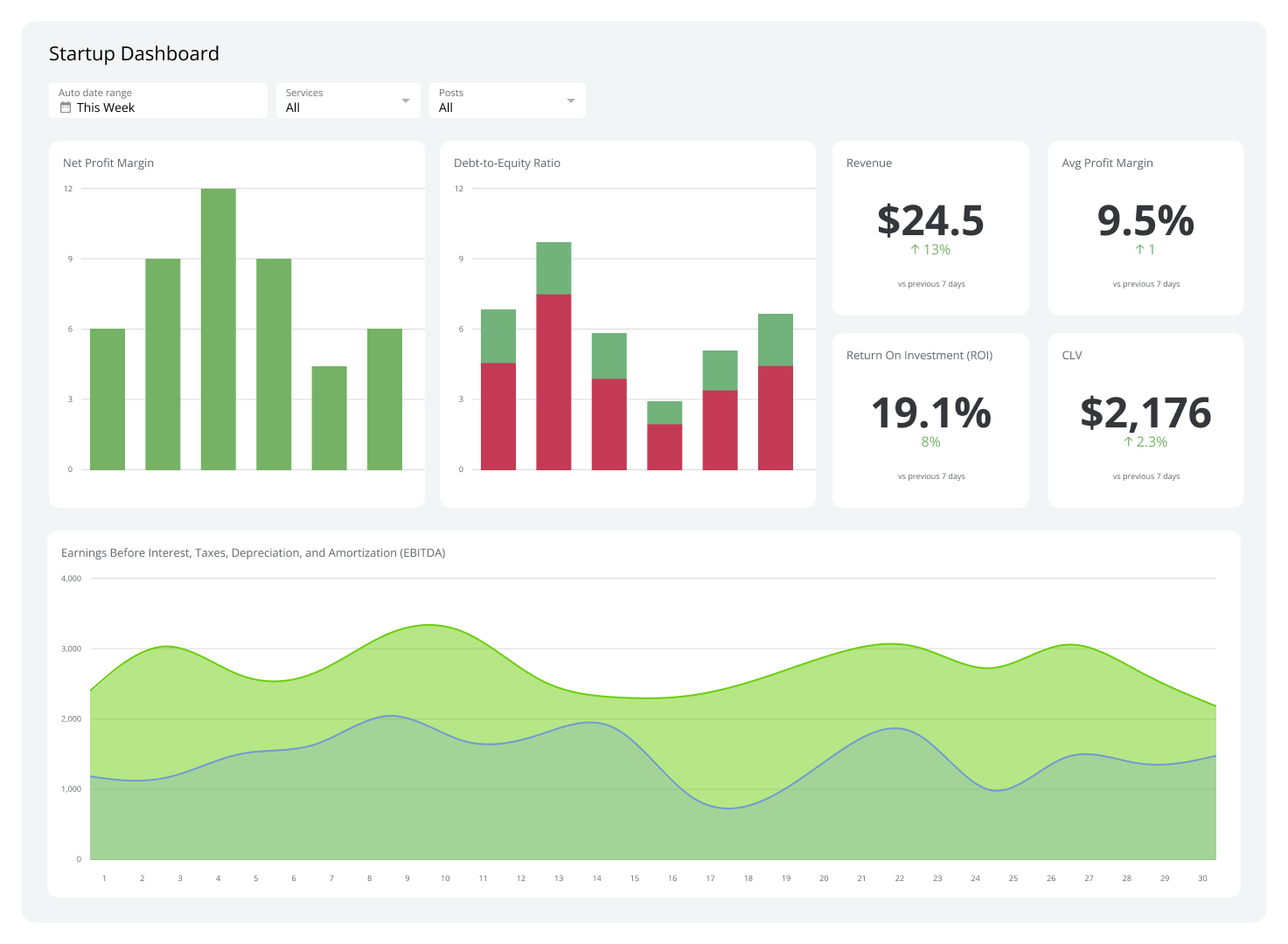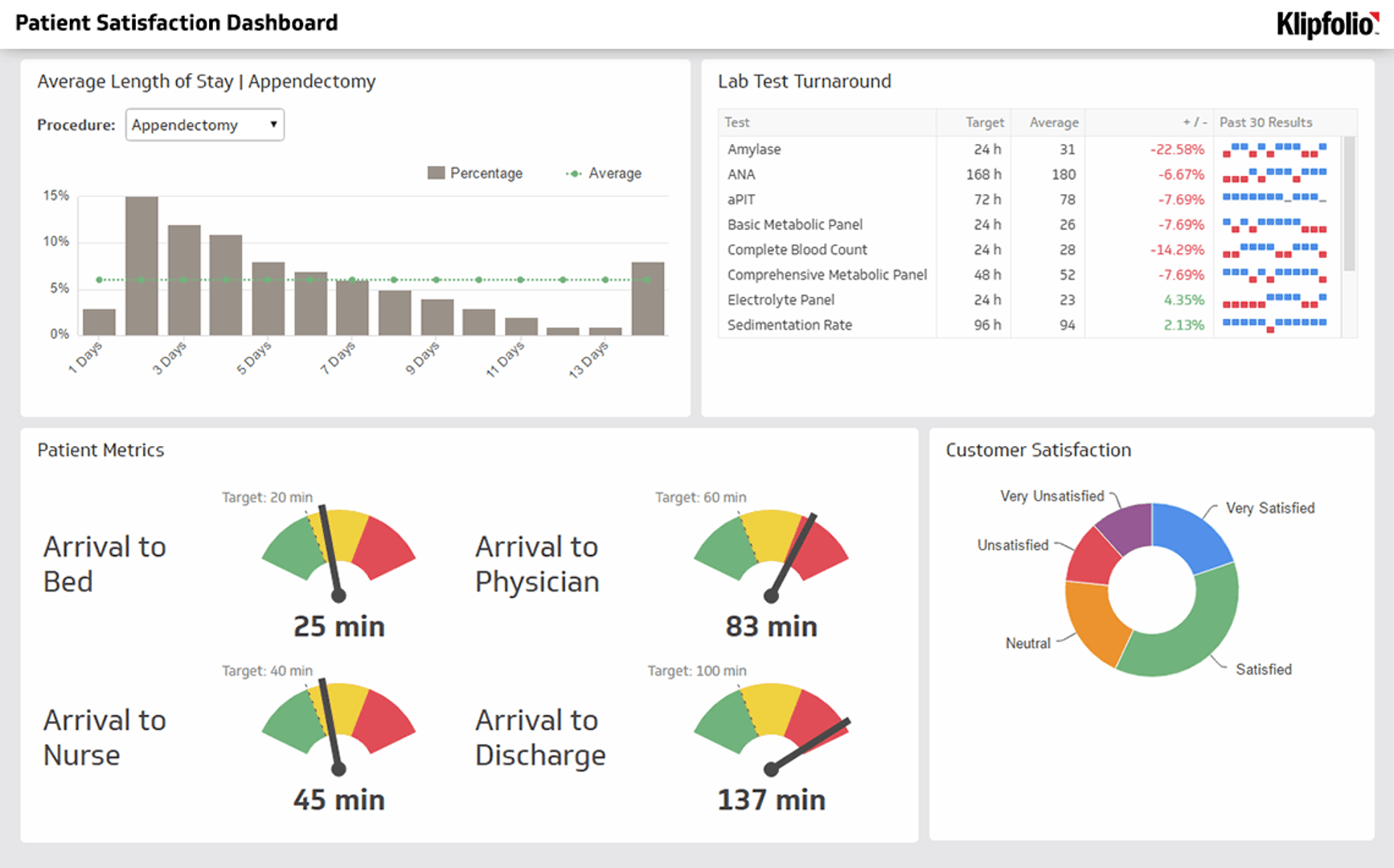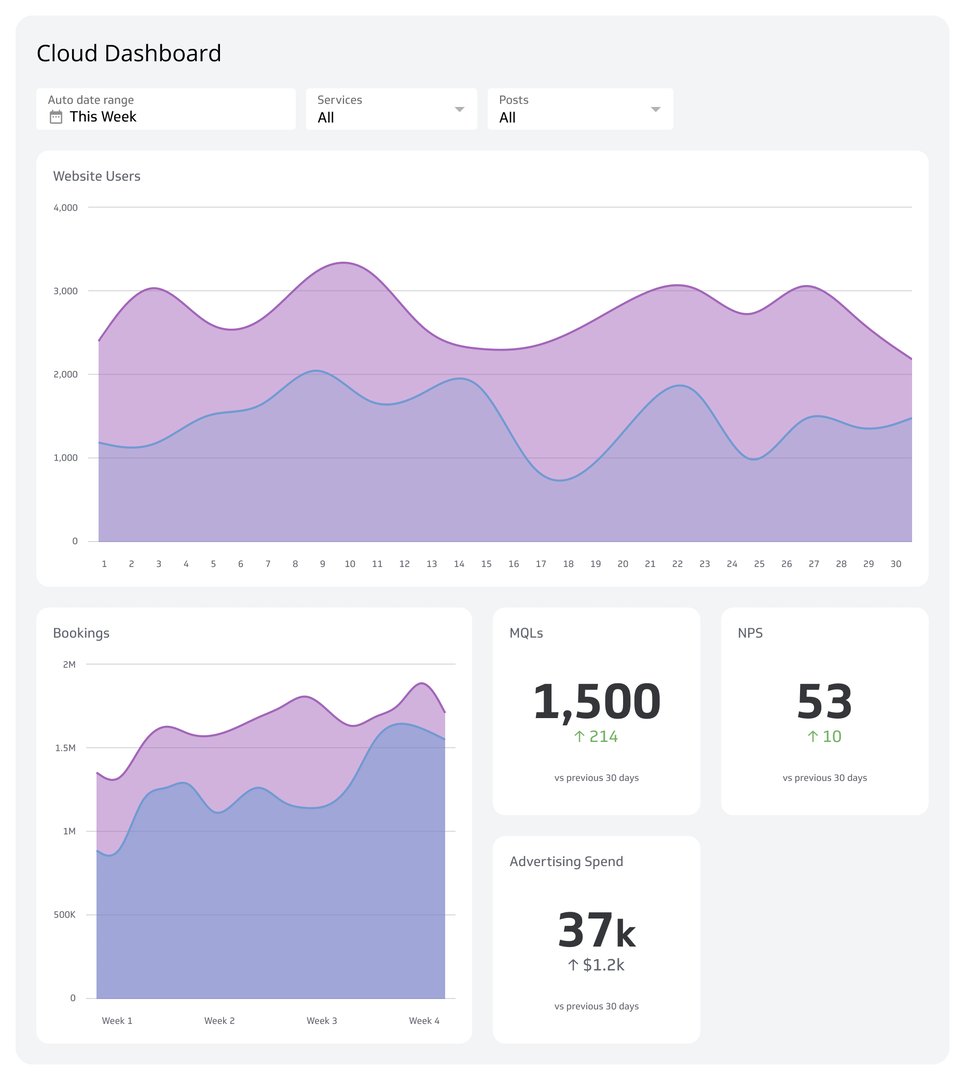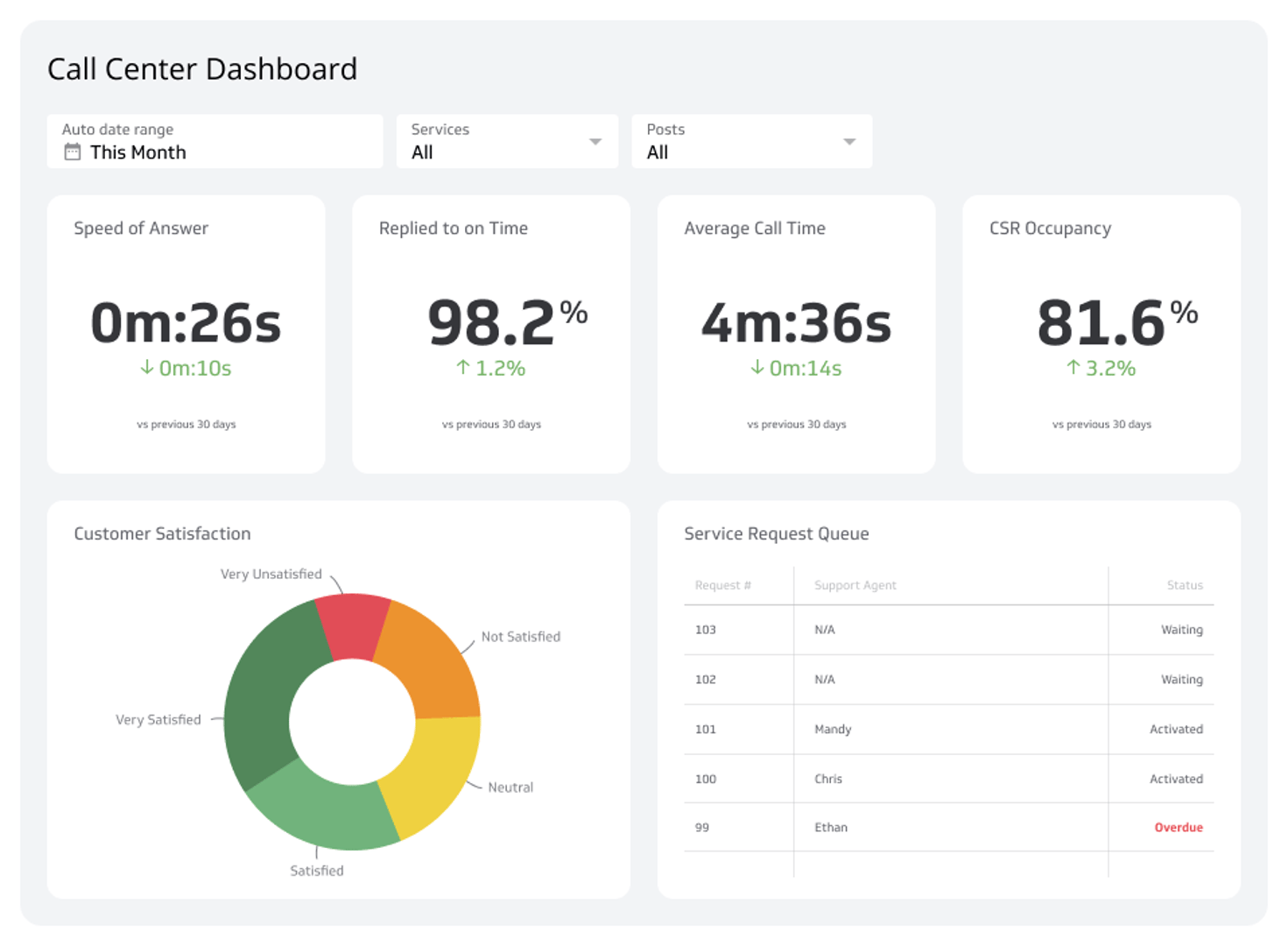Startup Dashboard
A startup dashboard utilizes interactive visualizations such as graphs, charts, and tables to help you stay updated on the metrics and KPIs that matter to your newly formed business.
What is a Startup Dashboard?
Startup dashboards acquire information from databases, web sources, reports, and AI to deliver metrics and KPIs in the form of easily understandable visuals such as graphs, charts, and tables.
For example, it can show you daily user acquisition rates, allowing you to instantly see how well your marketing efforts are doing. Meanwhile, for product-focused startups, the dashboard can show feature-use stats to help you spot which aspects of your offerings echo most with users.
Examples of Startup Dashboards
Operations Dashboard
An operations dashboard provides a deep look into the operational performance of your startup. Through metrics like production efficiency, inventory levels, and order fulfillment rates, the dashboard informs you how well your startup is running its day-to-day operations and where bottlenecks or inefficiencies exist.
Who’s it for | Operations managers, supply chain managers, production supervisors, company executives, quality control teams, logistics coordinators |
How often it's needed | Real-time, daily, weekly, monthly |
Covered KPIs | Production output, inventory turnover, order fulfillment rate, on-time delivery rate, equipment utilization rate, defect rate, cycle time, throughput, capacity utilization, overall equipment effectiveness (OEE), lead time, work-in-progress (WIP) levels, scrap rate, labor productivity, machine downtime, supplier performance metrics, warehouse capacity utilization, inventory accuracy, transportation costs, energy consumption, maintenance costs, safety incidents, quality control metrics, customer complaints, return rate, operational costs per unit, production schedule adherence, process yield, material waste, employee productivity, inventory days on hand, perfect order rate, cash-to-cash cycle time, forecast accuracy, backorder rate, pick and pack times, dock-to-stock time, supply chain visibility |
Marketing Dashboard
A marketing dashboard tells you how well your startup’s marketing efforts are doing. It shows metrics like customer acquisition cost and conversion rates to calculate the impact of your efforts. The information from this dashboard can help you develop winning marketing strategies, equip you with the knowledge needed to optimize your marketing mix, allocate budgets more effectively, and improve your return on marketing investment.
Who’s it for | Marketing managers, digital marketers, content creators, social media managers, company executives, brand managers, marketing analysts |
How often it's needed | Daily, weekly, monthly, quarterly |
Covered KPIs | Website traffic, conversion rate, customer acquisition cost (CAC), return on ad spend (ROAS), cost per click (CPC), click-through rate (CTR), bounce rate, social media engagement rate, email open rate, email click-through rate, lead generation rate, marketing qualified leads (MQLs), sales qualified leads (SQLs), brand awareness, share of voice, customer lifetime value (CLV), net promoter score (NPS), organic traffic, paid search traffic, content performance metrics, followers growth, video view count, marketing ROI, campaign performance, landing page conversion rate, cost per lead, average order value, customer retention rate, time on site, pages per session, social media reach, influencer marketing ROI, mobile vs desktop traffic, audience demographics, referral traffic, marketing-generated revenue, customer segmentation effectiveness, brand sentiment analysis |
Sales Dashboard
Sales dashboards supply a sweeping view of your startup's sales performance. They track the effectiveness of your sales tactics, highlighting working pitches, monitoring conversion rates at different sales funnel stages, and providing updates on revenue targets. Some metrics and KPIs you can expect it to prominently display include total revenue, sales by product/service, sales growth rates, and pipeline values.
Who’s it for | Sales managers, sales representatives, company executives, marketing teams, business development managers |
How often it's needed | Daily, weekly, monthly, quarterly |
Covered KPIs | Total revenue, sales growth rate, sales by product/service, sales by region, sales by customer segment, average deal size, win rate, sales conversion rate, sales cycle length, pipeline value, number of new opportunities, number of closed deals, sales quota attainment, CAC, CLV, lead-to-opportunity ratio, opportunity-to-win ratio, sales value productivity, sales forecast accuracy, cross-sell/upsell rates, customer churn rate, average profit margin, sales velocity, lead response time, number of sales calls/meetings, proposal win rate, sales funnel conversion rates, revenue per sales rep, customer retention rate, NPS |
Customer Satisfaction Dashboard
High customer satisfaction equates to a loyal customer base. A customer satisfaction dashboard illustrates how well your startup is satisfying customer expectations. It displays metrics showing how happy customers are with your products or services and how likely they are to recommend your business.
Who’s it for | Customer service managers, customer support representatives, company executives, product managers, marketing teams |
How often it's needed | Daily, weekly, monthly, quarterly |
Covered KPIs | NPS, customer satisfaction score (CSAT), customer effort score (CES), first response time, average resolution time, ticket volume, ticket backlog, customer retention rate, churn rate, CLV, CAC, customer feedback ratings, number of support interactions, support channel preference, self-service success rate, customer loyalty index, repeat purchase volume, rate of return, customer complaint rate, issue resolution rate, customer engagement score, customer satisfaction by product/service, customer satisfaction by support channel, customer satisfaction trends over time, average handling time, first contact resolution rate, customer survey response rate, customer sentiment analysis, customer satisfaction by customer segment, customer satisfaction impact on revenue |
Competitive Analysis Dashboard
Competitive analysis dashboards help startups better understand their position in the market relative to their competitors. They provide you with the insights necessary to refine your own strategy, identify potential threats, and capitalize on weaknesses in the competitive landscape.
Who’s it for | Marketing managers, product managers, company executives, sales teams, business development managers, strategic planners |
How often it's needed | Weekly, monthly, quarterly, annually |
Covered KPIs | Market share, competitor pricing, product feature comparison, brand sentiment analysis, competitor growth rate, share of voice, CAC comparison, CLV comparison, competitor marketing spend, social media engagement rates, website traffic comparison, search engine rankings, customer satisfaction scores, NPS, product launch success rates, innovation index, patent filings, research and development spending, employee satisfaction and turnover rates, financial performance metrics, geographic presence, distribution channel effectiveness, customer demographics analysis, pricing strategy effectiveness, promotional campaign performance, product portfolio diversity, market penetration rates, brand awareness levels, customer loyalty metrics, competitive win/loss ratio, time-to-market for new products, customer support performance metrics, sustainability and corporate social responsibility rankings |
Growth Dashboard
A growth dashboard tracks growth metrics across various aspects of your startup. It’s essential for assessing expansion and overall progress and allows you to identify the factors keeping the business afloat and thriving.
This dashboard can reveal surprising correlations, such as how changes in customer support response times affect user retention rates. More importantly, it serves as an early warning system that automatically alerts you of issues like a sudden drop in user engagement.
Who’s it for | Growth managers, marketing directors, product managers, sales leaders |
How often it's needed | Daily, weekly, monthly, quarterly |
Covered KPIs | User acquisition rate, customer retention rate, churn rate, monthly recurring revenue (MRR), annual recurring revenue (ARR), average revenue per user (ARPU), CLV,CAC, conversion rates, activation rates, onboarding completion rates, feature adoption rates, viral coefficient, NPS, user engagement metrics, revenue growth rate, market share growth, expansion revenue, upsell/cross-sell success rates, organic traffic growth, paid traffic ROI, social media follower growth, email list growth, app store rankings, customer support ticket volume, product usage frequency, time to value, cohort analysis, customer segment growth, sales pipeline velocity, lead-to-customer conversion rate, freemium to paid conversion rate, pricing optimization impact |
Social Media Dashboard
For startups, social media is one of the most cost-effective and impactful platforms to invest in, being able to open doors toward higher brand awareness, customer engagement, and growth. Social media dashboards give you a summary of your startup’s social media performance. They deliver live figures that showcase how your content resonates with audiences and how quickly your social media footprint is rising.
With this data, you’ll easily be able to monitor and adjust your online content strategy to expand your startup’s presence in the broader marketplace.
Who’s it for | Social media managers, digital marketers, content creators, brand managers, community managers, company executives |
How often it's needed | Daily, weekly, monthly, quarterly |
Covered KPIs | Total followers, follower growth rate, engagement rate, reach, impressions, CTR, post frequency, best-performing content types, audience demographics, sentiment analysis, share of voice, social media traffic to website, social media conversion rate, social media ROI, response time to messages/comments, user-generated content volume, video views and watch time, story views and completion rate, hashtag performance, influencer campaign metrics, social media ad performance (CPC, CPM), social listening metrics, brand mentions, social media lead generation, post timing effectiveness, social media customer service metrics, social media referral traffic, social media audience growth by platform, social share of web traffic, social media conversion path, social media-driven revenue, cost per engagement, audience overlap across platforms, dark social traffic, social media campaign performance, community growth rate, social media share of total marketing budget, brand advocacy rate, social media-driven email signups, social media content calendar adherence, social media crisis management effectiveness |
Expense Report Dashboard
An expense report dashboard tracks your startup’s spending patterns. It can help you identify areas for lowering budget allocation and optimizing costing.
This dashboard also helps you better reflect on your startup’s resource allocation. It highlights when you’re adhering to and exceeding budget guidelines, providing the necessary data to implement effective expense policies and more accurately forecast future expenses.
Who’s it for | Financial managers, accountants, department heads, company executives, project managers, expense approvers, budget planners |
How often it's needed | Daily, weekly, monthly, quarterly |
Covered KPIs | Total expenses, expenses by category, expenses by department, expenses by employee, average expense per employee, expense trends over time, budget vs. actual expenses, expense approval time, reimbursement turnaround time, policy compliance rate, top spenders, most frequent expense types, travel expenses breakdown, expense report submission timeliness, expense report rejection rate, expense anomalies detected, cost savings from expense reduction initiatives, expense to revenue ratio, cash flow impact of expenses, expense forecast accuracy, expense report processing costs, expense report cycle time, expense policy exception rate, expense report audit findings, expense report fraud detection rate, expense categorization accuracy, expense report volume trends, expense report automation rate, expense report approval rate, recurring vs. one-time expenses, fixed vs. variable expenses, expense allocation by project or client, expense report submission method (mobile vs. desktop) |
Inventory Dashboard
Inventory dashboards provide a real-time snapshot of your business’s inventory levels. They showcase how much capital is tied up in inventory and how fast products are moving through your supply chain. These dashboards display all the standard inventory metrics, including total inventory value, turnover rates, and dead stock percentage.
Regularly analyzing these allows you to streamline purchasing decisions, prevent stockouts, reduce excess inventory, and improve product management. This increased efficiency is essential for startups operating with limited resources and striving for rapid growth.
Who’s it for | Inventory managers, supply chain managers, warehouse supervisors, purchasing managers, operations executives, sales teams, financial planners |
How often it's needed | Daily, weekly, monthly, quarterly |
Covered KPIs | Total inventory value, inventory turnover rate, inventory-to-sales ratio, days of supply, stockout rate, excess stock rate, inventory accuracy, inventory shrinkage, average inventory age, slow-moving inventory, percentage of out of stock items, inventory carrying cost, reorder point adherence, safety stock levels, lead time by supplier, order fulfillment rate, perfect order rate, inventory to sales ratio, inventory write-offs, inventory obsolescence rate, economic order quantity (EOQ), cycle count accuracy, inventory forecast accuracy, inventory holding costs, inventory velocity, supplier performance metrics, inventory return rate, just-in-time (JIT) efficiency, inventory discrepancy rate, inventory-to-cash conversion cycle, average days to sell inventory, stock coverage ratio, inventory service level, inventory turnover by product category, inventory valuation method efficiency, demand forecasting accuracy, inventory replenishment cycle time, backorder rate, inventory to working capital ratio |
Sustainability Dashboard
ESG (environmental, social, and governance) is important for every business, and startups have the opportunity to build their sustainability profile right from the start. By looking at your newly-formed business’ resource consumption, social impact, and ethical practices, a sustainability dashboard helps you meet your ESG goals and improve your brand’s reputation.
Who’s it for | Sustainability managers, environmental officers, operations managers, company executives, regulatory compliance officers, supply chain managers |
How often it's needed | Daily, weekly, monthly, quarterly, yearly |
Covered KPIs | Carbon footprint, energy consumption, water usage, waste generation and recycling rates, renewable energy adoption, supply chain sustainability score, employee diversity and inclusion metrics, community engagement hours, ethical sourcing percentage, greenhouse gas emissions, resource efficiency, sustainability certifications, environmental compliance rate, sustainable product revenue, circular economy initiatives, biodiversity impact, air quality index, sustainable transportation metrics, employee health and safety incidents, sustainability training completion rate, stakeholder engagement score, sustainable packaging adoption, life cycle assessment results, green building certifications, sustainable investment allocation, sustainability reporting compliance, carbon offset initiatives, water stress assessment, sustainable supplier percentage, fair labor practices compliance, sustainability innovation index, product end-of-life management, renewable energy generation, sustainable procurement rate, corporate governance score, sustainability-linked compensation metrics, sustainability-related patents, eco-efficiency indicators, social impact measurement |
Boost your startup’s data acquisition with dashboards
Startup dashboards gather and consolidate all the metrics and KPIs relevant to your startup business. They acquire data from various sources and then convert it into easy-to-understand visualizations meant to give you a competitive advantage in an ever-changing market.
Klipolio gathers all your essential startup data in one place. Try it for free and unlock the power of raw data today.
Related Dashboards
View all dashboards



